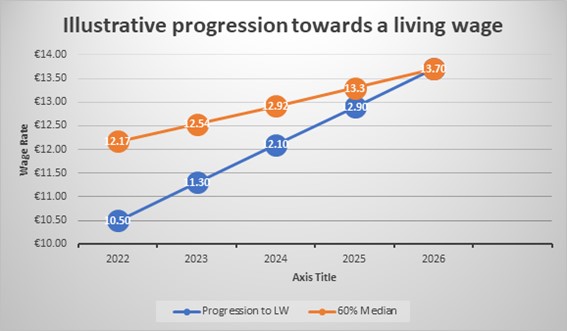14th June 2022
New living wage, phased in over 4 years, starting next year
60% of median wage proposed as new living wage
Building on his work to date to improve terms and conditions for workers, the Tánaiste and Minister for Enterprise, Trade and Employment Leo Varadkar TD today outlined his proposal to introduce a living wage for all employees, starting from next year. He will now consult with various interested parties, including employer and worker representative groups, unions and the public on the draft plan.
Last year, the Tánaiste asked the Low Pay Commission to conduct research and report to him on how best the Government can progress to a living wage. Today’s proposals are based on these recommendations.
The Tánaiste said:
“Better terms and conditions for employees must be one of the legacies of the pandemic. The living wage will build on the programme of improvements we are making, from introducing mandatory sick pay, to auto enrolment for pensions, to putting in place the laws, regulations and infrastructure to give people more flexibility over how and where they work.
Thank you to the Low Pay Commission and NUI Maynooth for all their work and research. The proposal I am outlining today is based on the LPC’s recommendations. It’s really important we get the balance right and I think this proposal achieves that, however I will be listening over the coming weeks for feedback before bringing a final plan to Government later this year.”
Proposal for introducing a living wage for all workers
- The living wage will be set at 60% of the median wage in any given year, which in 2022 would be €12.17 per hour. The national minimum wage is currently €10.50 per hour.
- The national minimum wage will remain in place until the 60% living wage is fully phased in, in 2026, but will increase over the years as usual, closing the gap between it and the living wage.
- From 2026, we will no longer have a national minimum wage, the living wage will be the floor and will be mandatory for all employers.
- Depending on prevailing economic circumstances, it is proposed to give the Low Pay Commission discretion to introduce the full living wage faster or slower than the 4 years proposed.
Research carried out by the National University of Ireland, Maynooth for the Low Pay Commission includes evidence that a statutory wage floor set at 60% of the median wage of all workers could be implemented without substantial effects on employment.
The Tánaiste said,
“We’re making a huge amount of improvements to workers’ rights and terms and conditions this year and I’m really conscious that, although we have more people working than ever before in the history of the state, employers have had a turbulent and difficult couple of years and many are still just getting back on their feet. I’m also aware that we have a really uncertain period ahead. The most important workers’ right is their right to work, to have a job. That is why I am proposing we phase this in and I will be listening to employers’ views on these draft proposals.”
The Low Pay Commission’s report on the Living Wage, and the accompanying research report, are available at Low Pay Commission publications (www.gov.ie).
The Department of Enterprise, Trade and Employment is conducting a public consultation on the phase in of the living wage.
Notes to Editor
The Low Pay Commission is an independent body established under the National Minimum Wage (Low Pay Commission) Act 2015 and comprises equal numbers of employer representatives, employee representatives, and independent experts.
The Commission made eighteen recommendations to phase in a new living wage. The main recommendations are as follows:
- Adopting a fixed threshold approach for the calculation of a living wage (as opposed to a Minimum Essential Standard of Living / “basket of goods” approach) and setting the fixed threshold at 60% of the median wage in the economy, under the assumption of a 3% rate of growth in the median wage;
- Progressing to a living wage of 60% of the economy-wide median wage through a gradual adjustment to the minimum wage over a period of no more than five years;
- After the 60% of the median wage target has been reached, subject to an assessment of the impact of the progression to the 60%, the Commission should assess the economic practicality of gradually increasing the targeted threshold rate towards 66% of the median wage;
- Consideration is given to how employers with a substantial proportion of minimum wage employees can be supported during the progression to a living wage.
- Consideration of the impact of a move to a living wage rate on the take home pay of different categories of workers to ensure that low wage workers receive a reasonable increase in take home pay.

Note the above graph is for illustrative purposes only, the exact rates will depend on median wages in any given year and what the Low Pay Commission decides to recommend as the national minimum wage.
Back to Department News